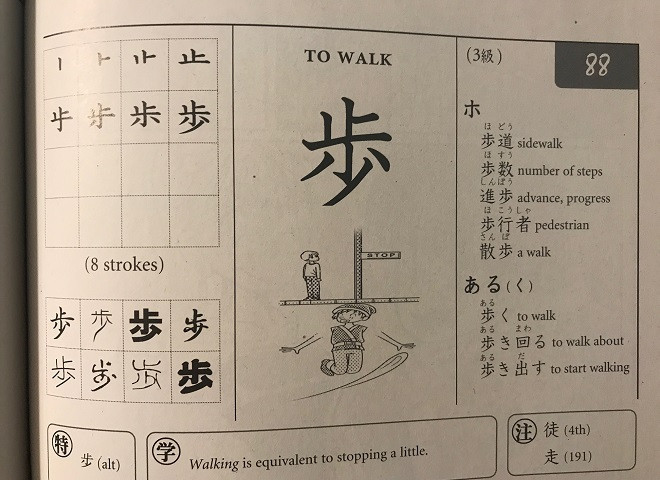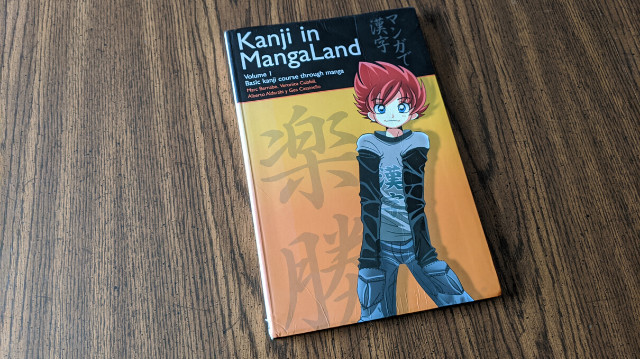There are a ton of books that teach people kanji. Some of them focus on meanings, others on readings, and a lot try to tackle them both. One of the more unique approaches I’ve come across uses manga as an essential ingredient. This post is my Kanji in MangaLand review.
The full title of the book is Kanji in MangaLand: Volume I Basic kanji course through manga by Marc Bernabe et al.
I’m going to start off by talking about this book and the series that it belongs to. There are not only multiple MangaLand kanji books, but also some other that focus on grammar and vocabulary.
Then I’ll talk about what this book teaches and how it specifically does so. I’ll also give my personal thoughts on it and where you can find it if you’re interested.
The Book And The Series
This book is the first in a duo for the kanji series. It introduces the concepts that it uses for helping people learn and remember kanji, along with the example manga panels and exercises to lock information in.
It then goes over several hundred kanji for people to learn in the first volume.
The second volume continues where the first one ends, and is really just a lot more of the same. The second book is about twice as thick as the first one, so once you’ve got the system down from the first one, you can just continue using it throughout the next one to learn more and more kanji.
As for the other part of the MangaLand series, there are three grammar books that take people from absolute beginner in Japanese up to the intermediate stage. There are also two workbooks that are optional for the grammar series which are actually pretty good.
If you want to learn more about this grammar series, then check out my review on Japanese in MangaLand.
Otherwise let’s get back to this kanji book specifically.
Contents Of This Book

The book can be used in combination with other Japanese studies, or it can be a standalone item.
It’s designed to be a self-study tool that teaches the first 240 kanji that Japanese kids learn in school. In addition to this, it also teaches people how to learn hiragana and katakana (the two Japanese syllabaries) so that people who no nothing about Japanese can start learning the written part of the language with this book.
As you can see from the above picture, it teaches a lot of different things about each kanji. In the middle it what the kanji looks like and its meaning in English.
As for the pictures right below the kanji 歩 (to walk), I will explain what those are for in the next section.
In the top left it shows the stroke order so that you can practice writing the kanji to assist in memory. It also it useful for learning how to write Japanese.
Below that are some different versions of the kanji, which will sometimes appear depending on what font is being used in the material that you read. It’s a nice thing to look over, but there’s not much need to memorize it.
Over on the right side we see the readings of the kanji, both the on’yomi and the kun’yomi along with example words that help to illustrate how the kanji is used.
The bottom left box shows an alternative version of the kanji that is sometimes used for the same meaning, and then over on the bottom right we see some similar looking kanji that are easy to confuse with the one being taught.
This is a little warning to let the reader know not to mix them up with one another.
Now let’s talk about those pictures along with the box in the bottom middle that tells a story in this next section.
The Method It Uses
The method that this book uses to help people remember the meaning of the kanji is a combination of mnemonics (a story telling technique that helps with memory) and the use of pictures that illustrate this story.
In the particular case of the picture above, the kanji 歩 for “to walk” is actually made up of the following two kanji:
- 止 (to stop)
- 少 (a little)
The pictures are uses to help people visualize the meaning of the kanji in order to remember them. This works pretty well for the simple kanji.
However, sometimes the kanji are more complicated and no single picture will work, so what the book does is combine those pictures into a story that helps people remember.
In this case, they went with the story that “walking is equivalent to stopping a little.”
The “walking” part is this new kanji’s meaning, and the “stopping” and “a little” part come from those individual kanji that make up the new one.
This technique is nothing new, and I believe the author’s friendship with James Heisig who wrote the well-known book Remembering the Kanji (RTK) which uses a nearly identical method.
But since Kanji in MangaLand also incorporates the use of kanji, it focuses a lot more on visual memory and visual cues to help people remember the meaning of a kanji, whereas RTK uses a person’s imaginative memory instead.
At any rate, the MangaLand book is divided into chapters that teach a number of kanji this way, and then at the each of each chapter is a full page of manga that uses the kanji that were taught in previous lessons.
Then after you finish reading the manga, there is a section on exercises that help you practice writing the kanji, choose the correct reading for kanji, recall the meaning of kanji, and make corrections on the Japanese spellings of various kanji.
After you complete all of the exercises, there is a section that contains all of the answers for you to check, along with an English translation of the manga which you can read to see what you understood correctly and what you still need to work on.
At the back of the book there are also some indexes that help you to look up specific kanji when you need to.
Personal Thoughts On It

Personally I found this book to be a lot of fun and a helpful tool in learning new kanji.
There’s a lot of information in each section, and learning it all at the same time can lead to overload, so I think it’s best to take it slow and review kanji that were previously learned as needed.
My favorite part of the book was by far the manga panels, and I really wish that there were more Japanese learning materials like it since it made the process a lot of fun.
While learning kanji and Japanese in a systematic way is helpful, and to a certain extent necessary for non-native Japanese people, it really just doesn’t compare to the joy of reading and understanding actual Japanese material.
I think that there are a lot of really great books out there that teach people kanji, and this one is not the fastest or the most extensive, but there’s no doubt in my mind that it is the most fun way to learn that I’ve ever used.
I’ve got both the first volume and the second, so that ought to speak to its worth.
Having said that, I will admit that I am biased because learning Japanese to read manga was my original reason for learning the language.
If you are a person who is more interested in reading Japanese novels instead of manga, then you probably won’t get a lot out of using this book.
Where To Find It
I love manga, and I love Japanese. This book was able to combine those two things into a system that help me and other people learn new kanji.
Kanji in MangaLand is the funnest book I’ve used for learning how to read and understand kanji.
Thanks for reading my review!
If you have any comments or questions that you would like to make, then please feel free to do so down below.
Further Resources for Learning Japanese:
#3 Get My eBook (Secrets to Learning Japanese) for Free

またね!

Thank you for your post, it was very well written and i enjoyed it. I love anime, manga and light novels so I’ve always wanted to learn to learn the language. I discovered this book by chance while looking for a decision mathematics textbook. I was actually looking for info about the other series and was surprised and a little confused that there was another series as well. By the way i heard there is a similar series called “Japanese the Manga Way” though your probably aware. Again thank you for such nice content
Hey, it is my pleasure. And thanks for the kind words!
Yeah, I only recently got a copy of Japanese the Manga Way and I really liked it. I thought that it used both a fun way to teach the language, as well as a unique perspective on the Japanese language. If I remember correctly, the author grew up bi-lingual (English and Japanese) so he has a really thorough understanding of both languages.
It’s pretty cool that the book shows several different fonts for the kanji. That’s one of the hardest things for me, reading kanji that is “stylized” so it looks cool. How many kanji are in the second book of this series?
The second book goes over 400 kanji, which is almost twice as many as the first book that teaches 240.
The original plan that the authors had was to release three books that would comprise the 1,006 教育漢字 (Education Kanji) that Japanese children learn during their six years in elementary school.
Unfortunately, only the first two books were ever released. I don’t know what ever happened to the third book, but my guess is that it was cancelled due to poor sales.
The second book was published in 2009, so almost ten years ago. Oh well, I suppose that we can use them for the kanji they cover, and then do the rest on our own. しょうがないなぁ
Yeah I’ve learned hiragana and katakana without too much trouble using Memrise. They do a pretty good job of making it fun to learn Japanese. But kanji still gives me some trouble. My biggest problem is when there are several kanji that all look similar, but have only a slight difference. I don’t know, is that normal to struggle with kanji that look almost identical?
I think it’s a pretty common thing. I certainly have done that in English, where I’ll just glance at a word without fully reading it and I’ll say it wrong out loud. Same thing with kanji, if you don’t pay attention to all the radicals while you are learning them, you tend to get confused later on when you encounter similar ones.
Learning Kanji is really difficult. It is hard to pronounce, hard to write and hard to recite the word. Therefore, I am finding ways to make the learning process easier and more interesting. I find your suggestion useful. We can learn Kanji by reading comics. Thank you for your great review!
Hey Billy, my pleasure! I agree, kanji is probably the hardest thing to learn when it comes to Japanese. I’m glad I could help! ^_^